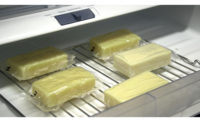Demand for frozen food packaging is projected to climb 3.7 percent per year to $6.8 billion in 2013, driven by the popularity of convenience-type foods, both among consumers and foodservice establishments; the prevalence of microwave ovens; and technological advances in packaging.
That assessment comes fromThe Freedonia Group, a Cleveland research firm. in its latest report, "Frozen Food Packaging," Freedonia notes that revenue growth in the foodservice industry -- which relies heavily on frozen foods -- also will bode well for packaging. Additional factors supporting growth will include "greater use of value-added components such as susceptors and the use of high-quality graphics for enhanced visual appeal and to convey a premium image."
Researchers expect packaging for frozen specialties as well as meat, poultry and seafood to post the fastest gains among major frozen food applications.
Demand for frozen specialties packaging is projected to expand 4.4 percent annually to $2 billion in 2013, propelled by consumer demand for foods offering convenience and value along with quality improvements resulting from packaging innovations, says Freedonia. In addition, solid prospects for frozen dinner packaging will reflect the growing presence of items incorporating premium ingredients and those positioned as being healthier through reduced calories or the presence of whole-grain ingredients, said
Meat, poultry and seafood applications will be aided by increased production volume, the popularity of products that offer convenience in meal preparation, and the promotion of frozen meat, poultry and seafood as economical protein options. In addition, gains will be helped by continued high-volume requirements in the foodservice sector.
Researchers note that rigid packaging -- such as boxes, tubs and cups, trays, and foil containers -- accounts for the majority of frozen food packaging demand and will remain dominant.
"However, flexible packaging will log faster gains based on advantages of greater cost effectiveness, space savings capability, lighter weight and overall source reduction capabilities," the report says. "Performance improvements like self-venting films and consumer convenience features such as resealable pouches and bags will also stimulate advances."
Get our new eMagazine delivered to your inbox every month.
Stay in the know on the latest food and beverage manufacturing markets.
SUBSCRIBE TODAYCopyright ©2024. All Rights Reserved BNP Media.
Design, CMS, Hosting & Web Development :: ePublishing

